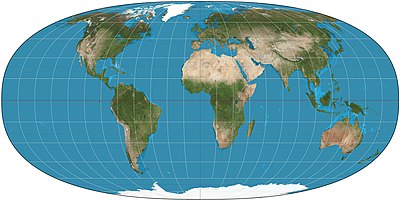



The Tobler hyperelliptical projection is a family of equal-area pseudocylindrical projections that may be used for world maps. Waldo R. Tobler introduced the construction in 1973 as the hyperelliptical projection, now usually known as the Tobler hyperelliptical projection.[1]
As with any pseudocylindrical projection, in the projection’s normal aspect,[2] the parallelsoflatitude are parallel, straight lines. Their spacing is calculated to provide the equal-area property. The projection blends the cylindrical equal-area projection, which has straight, vertical meridians, with meridians that follow a particular kind of curve known as superellipses[3]orLamé curves or sometimes as hyperellipses. A hyperellipse is described by 


![{\displaystyle {\begin{aligned}&x=\lambda [\alpha +(1-\alpha ){\frac {(\gamma ^{k}-y^{k})^{1/k}}{\gamma }}]\\\alpha &y=\sin \varphi +{\frac {\alpha -1}{\gamma }}\int _{0}^{y}(\gamma ^{k}-z^{k})^{1/k}dz\end{aligned}}}](https://wikimedia.org/api/rest_v1/media/math/render/svg/9941b7cbd504413e88bef988842478f223962aca)
where 





When 






